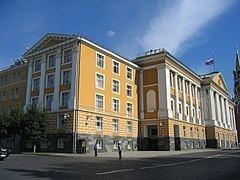Alternative names Building 14 Completed 1934 Demolished 2015 Construction started 1932 | Current tenants Demolished Opened 1934 | |
 | ||
Similar | ||
The Kremlin Presidium (Russian: Административный корпус Кремля), also known as Building 14 (Russian: 14-й корпус), was a building within the grounds of the Moscow Kremlin in Russia. Constructed in 1934, until 2011 it housed the Supreme Soviet, the highest legislative body of the Soviet Union until its dissolution in 1991, and later the offices of the Presidential Administration of Russia. Demolition of the building began in late 2015.
Contents
Building
The Kremlin Presidium was located in the northern part of the Kremlin grounds, next to the Kremlin Senate, forming one side of Ivanovskaya Square. The four-story building had three wings opening towards the Senate, connected by a central building which faces the Taynitskaya Garden to the south. The southern facade had a row of Ionic order columns, with a gable roof in the center, reflecting the Neoclassical style of the adjacent Senate building. However, the wing halls were much simpler and less conspicuous. The building had three floors and was painted in the same yellow color as many other administrative buildings within the Moscow Kremlin.
History
The Presidium stood on the site of Chudov Monastery, founded in 1365 by the Metropolitan Alexius, the Ascension Convent, and Lesser Nicholas Palace. These were among the historic buildings with the grounds of the Kremlin ordered to be destroyed by Joseph Stalin as part of the state atheism campaign, which resulted razing of religious structures from all over Russia. Work on a new administrative building for the Soviet government began almost immediately, and Ivan Rerberg, a prominent Moscow architect who had designed Kiyevsky Rail Terminal was assigned to the task.
The new building was completed in 1934, two years after Rerberg's death. Initially, it had no name, and was used as the Red Commanders School, a military academy for Red Army leaders. The school was relocated in 1935, and from 1938, housed the offices of the Presidium of the Supreme Soviet, whose head was the titular de jure head of state of the Soviet Union.
From 1958–61, part of the building was converted into the 1,200-seat Kremlin Theatre (Кремлёвский театр). It, however, proved to be an awkward venue, and its functions were later transferred to the newly-built State Kremlin Palace.
Demolition
In 2001 it was slated for repair. After the relocation of the Presidential Administration offices to the Staraya Ploschad in 2011 building grew to a close and key works of renovation begun, originally planned to be completed by 2015. Despite the renovation process was going for several years already, a move criticized for the unwise spending of the public funds, the new ideas emerged. It was decided not to renovate the building, but to demolish it entirely : in 2014 the President Vladimir Putin proposed the restoration of the Chudov and Ascension monasteries and Lesser Nicholas Palace, demolished in the Thirties to free the space for the building.
This move, if approved, would radically change the Kremlin layout and essentially restore the historical outlook of the Ivanovskaya Square. At the same time experts doubt the possibility of such reconstruction due to lack of matter.
Meanwhile in was announces to create a new park in that place. In April 2016 the building was demolished. A little earlier the closed public entrance through the Spasskaya tower was open to allow the direct through passage between the Red Square and Alexander Garden (it was closed for public after the Bolshevik Government moved there after the Revolution).
